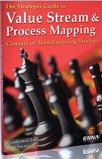Six General Steps to Lean Strategy
To develop a Lean Manufacturing Strategy and implementation plan, we recommend six general
steps:
-
Evaluate
The Current State
-
Identify
"Key Manufacturing Task(s)."
-
Determine
The Future-State Workflow (In Principle)
-
Select
The Lean Elements & Infrastructure
-
Identify
Precedents and Priorities
-
Develop
The Plans
1.
Evaluate The Current State
Our Lean
Manufacturing Assessment is a good tool for this. It examines nine key areas and points the
way to appropriate improvement techniques.
Process Mapping and Value Stream Mapping are also valuable.
2. Key Manufacturing Task
The Key Manufacturing Task is the task that is most important for competition in the market.
It provides the focus in Focused Factories. A
factory should have only one or two such Key Manufacturing Tasks according to
Wickham Skinner.
Identifying the Key
Manufacturing Task starts with what Terry Hill terms "Order Winning Criteria" or "Market
Criteria." Market Criteria are the factors that customers use to decide among competing sellers.
We should, in effect, ask the customers why they bought a particular product. Their responses
lead to the task that must be accomplished to win new orders.
3.
Future State Workflow
Workflow emanates from
process and layout. What equipment does the work and where it is. For many (but not all)
manufacturers, workflow is the best place to start. It corresponds to von
Clausewitz'
"center of gravity." With a
streamlined workflow, many other things become easier.
In the beginning, you will not know the final layout and arrangement of the factory. However,
you should be able to:
-
Determine where
cellular manufacturing will apply and where it may not.
-
Identify probable
Focused Factories.
-
Identify "monuments"; equipment that is large, expensive and
operates on many different products. These are likely to remain in functional areas.
-
Identify where a few new machines might untangle a complex workflow.
-
Evaluate equipment utilization policies that may encourage complex workflows.
For shops with hundreds or thousands of parts, this requires experience in
Group Technology. Without such a background,
visualization of the future state is difficult.
The paradox is that the larger the number of parts, the more likely it is that workcells will
be viable.
It does take work to untangle the mess and identify cells. It often requires sophisticated
methods. Our series on Group Technology
explains.
4. Identify Your Lean Elements
Based on the vision of the future state, pick the appropriate elements of Lean Manufacturing
from the Lean Laundry List. You may also identify other advanced manufacturing techniques that
are not on the usual lists of Lean Manufacturing.
|
Future State Infrastructure
Infrastructure supports or enables the process. Infrastructure includes:
-
Scheduling
-
Training
-
Culture
-
Organization Structure
-
Quality Methods
-
Utility Systems
-
Costing Systems
-
Investment policies
-
...Many Others
Here, again, experience is important. Not because the problem is so difficult but because the
paradigm is so different.
5. Identify Precedents and Priorities
Precedence may require the use of certain elements to make some other element practical. For
example, Rapid Setup (SMED) may be necessary
to enable kanban. In addition, workcells make kanban simpler and easier. Workcells also function
better with small lots. The precedence might therefore be Workcells, SMED,
kanban. In reality, these are likely to be concurrent
as much as sequential.
Priorities depend partly on precedence but they also depend on ROI. By giving priority to
elements, products and areas that promise the fastest and largest returns, the transformation
becomes self-financing.
Prioritizing
Example
 Some companies start with 5S. They want to clean the place up. This seems like a good thing
and Martha Stewart would surely approve. However,
Cellular Manufacturing might be a
better starting point for the following reasons: Some companies start with 5S. They want to clean the place up. This seems like a good thing
and Martha Stewart would surely approve. However,
Cellular Manufacturing might be a
better starting point for the following reasons:
-
The return on 5S is lower, less immediate, and less obvious than for workcells.
-
If workcells come after 5S, much of the 5S work must be redone.
-
A rearrangement into cells automatically includes much of the cleanup and fix-up work of
5S.
-
Workcells are smaller, tighter and more focused than functional areas. They are easier to
keep clean. With workcells, 5S is easier, faster and more effective.
-
The inventory and material handling reductions from Cellular Manufacturing make the plant
easier to manage and clean.
Another factor for priorities is the "Low Hanging Fruit" principle. For various reasons, it
may be very quick and easy to implement one or another element. It makes sense to give such
elements higher priority.
6. Develop The Plans
With a broad overview of the situation, a vision for the future and knowledge of precedents
and priorities, we can now plan our action.
|





